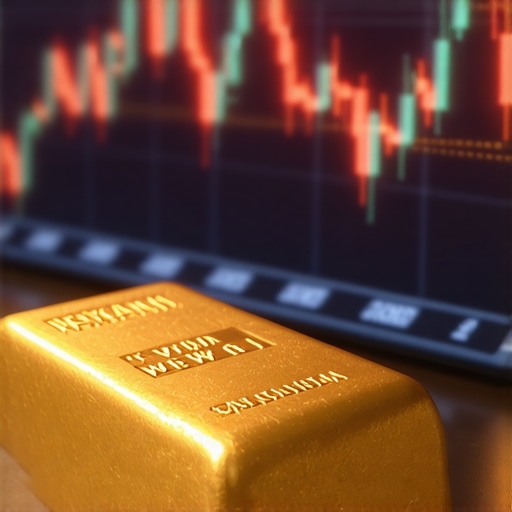Advanced Dynamics Shaping Gold Price Forecast 2025
Forecasting the gold price for 2025 demands a nuanced understanding of multifaceted market forces beyond mere historical price analysis. Gold’s valuation is influenced by an intricate web of global economic indicators, geopolitical tensions, central bank policies, and evolving supply-demand paradigms. Investors and analysts alike must engage with these layers to anticipate price trajectories with precision and confidence.
Macroeconomic Catalysts and Inflationary Pressures
Inflation remains a primary driver affecting gold prices, as the metal traditionally serves as a hedge against currency debasement. The interplay between inflation expectations, real interest rates, and monetary stimulus programs significantly impacts gold’s appeal. In 2025, persistent inflationary pressures amidst tightening monetary policies by major central banks could create volatility, challenging simplistic price predictions. Understanding these monetary dynamics is crucial for investors strategizing around gold’s inflation-hedging properties.
How Do Central Bank Gold Purchases Influence 2025 Market Trends?
Central banks play a pivotal role in shaping gold market dynamics through their buying and selling activities. Strategic gold acquisitions by emerging economies, coupled with reserve diversification away from fiat currencies, have amplified demand and price support. In 2025, continued aggressive gold purchases by central banks, especially in Asia and the Middle East, are expected to underpin gold prices. This trend reflects a broader geopolitical recalibration influencing global reserve management strategies and is analyzed in detail in expert analyses on central bank gold purchase impacts.
Supply Constraints and Mining Industry Challenges
Gold supply dynamics are equally critical. Mining output faces geological, environmental, and regulatory hurdles that constrain production growth. The declining quality of ore deposits and increasing extraction costs suggest limited supply elasticity, which, when paired with rising demand, supports upward price momentum. Investors should monitor mining sector developments and explore insights on top gold mining stocks poised for growth as part of a diversified investment approach.
Demand Shifts Driven by Technological and Cultural Factors
Beyond traditional safe-haven demand, gold’s utilization in technology sectors, including electronics and green energy, is expanding. Cultural demand, notably in India and China, fluctuates with socio-economic trends and regulatory environments affecting jewelry consumption. These demand vectors contribute to price complexity, emphasizing the importance of a comprehensive analysis incorporating both macro and microeconomic factors.
Call to Action: Deepen Your Gold Market Insights
For professionals seeking to sharpen their investment strategies in gold, exploring detailed forecasts and market signal interpretations is invaluable. Discover expert-level perspectives and forecast highlights at expert analysis on gold price trends and forecasts for 2025. Engage with this resource to refine your portfolio approach amid evolving global market conditions.
Authoritative Reference
For an academically rigorous perspective on gold price determinants and macroeconomic linkages, see the comprehensive review by the World Gold Council published in their 2024 market outlook report, accessible at World Gold Council Gold Outlook 2024.
Investor Sentiment and Behavioral Economics in Gold Pricing
While macroeconomic indicators and supply-demand fundamentals shape the groundwork of gold price forecasts, the psychological component of market participants cannot be understated. Behavioral economics reveals how emotions, biases, and herd mentality often drive gold price volatility beyond rational fundamentals. For example, during periods of geopolitical tension or economic uncertainty, heightened fear and risk aversion amplify gold’s safe-haven appeal, leading to sharp price spikes. Conversely, in bullish equity markets, complacency may depress gold demand temporarily despite inflationary pressures.
Understanding these sentiment-driven market dynamics allows sophisticated investors to better time entry and exit points. Incorporating sentiment analysis tools and monitoring market positioning data can provide an edge in anticipating short-term price movements and volatility.
Emerging Gold Investment Vehicles and Their Market Implications
The landscape of gold investment continues to evolve with the rise of innovative financial instruments. Beyond traditional physical gold and mining stocks, gold-backed ETFs, mutual funds, and digital gold platforms have expanded accessibility and liquidity. These instruments democratize investment but also introduce new factors influencing price discovery, such as fund flows, redemption patterns, and regulatory changes affecting exchange-traded products.
Investors must critically evaluate the trade-offs between convenience and control, as well as understand the nuances of each vehicle’s exposure to gold price fluctuations. For detailed insights on balancing exposure between physical gold and equities, explore our comprehensive guide on building a balanced gold portfolio with ETFs and stocks.
How Can Advanced Data Analytics Enhance Gold Price Forecasting Accuracy in 2025?
With the increasing complexity of gold markets, traditional forecasting methods based solely on historical price trends and macroeconomic indicators may fall short. Advanced data analytics, including machine learning algorithms and big data integration, offer promising avenues to capture nonlinear relationships and emerging market patterns.
These technologies can synthesize diverse datasets — from central bank transactions, mining output reports, geopolitical event tracking, to social media sentiment analysis — enabling more dynamic and adaptive forecasting models. However, the challenge lies in model transparency and the risk of overfitting in volatile markets. Integrating expert judgment with algorithmic outputs remains essential for robust decision-making.
Strategic Implications of Gold Price Volatility for Portfolio Management
Gold’s volatility, while often perceived as a risk, can be strategically harnessed within diversified portfolios to enhance risk-adjusted returns. Tactically adjusting gold allocations in response to market signals—such as shifts in interest rates or geopolitical risk—can provide downside protection and capture upside during crisis periods.
Moreover, employing derivative instruments like gold futures and options allows investors to hedge exposures or leverage positions efficiently. For those interested in mastering these techniques, our guide on gold futures trading essential tips offers practical strategies to navigate price swings confidently.
Authoritative Reference
For a cutting-edge perspective on how data analytics and behavioral finance are revolutionizing commodity price forecasts, including gold, see the detailed analysis by the International Monetary Fund in their 2023 report on Behavioral Finance and Commodity Price Forecasting.
Engage With Us: Elevate Your Gold Investment Strategy
We welcome your insights and experiences navigating the complex gold market landscape. Share your thoughts in the comments below or join the conversation on social media. For further expert analysis, consider reading our detailed outlook on 2025 gold price forecasts and expert market signals to stay ahead in this dynamic investment arena.
Decoding Market Sentiment: Behavioral Economics as a Catalyst in Gold Price Fluctuations
In the complex ecosystem of gold pricing, behavioral economics introduces a profound layer of insight often overlooked by traditional models. Investors’ psychological biases—such as loss aversion, overconfidence, and confirmation bias—exert tangible impacts on gold demand and price volatility. For instance, during episodes of geopolitical upheaval or sudden economic downturns, collective investor fear triggers a flight to safety, dramatically inflating gold prices beyond what fundamentals alone would justify. Conversely, when equity markets are buoyant, the allure of gold can diminish sharply, underscoring the non-linear and sentiment-driven nature of gold price movements.
Incorporating sentiment indicators like the Commitment of Traders (COT) reports, investor surveys, and social media analytics provides nuanced signals that enrich conventional macroeconomic forecasting. Such data empower market participants to anticipate behavioral-driven price anomalies and position accordingly, thereby enhancing portfolio resilience amid volatility.
Technological Innovations: Leveraging Machine Learning to Unravel Gold Market Complexities
The advent of sophisticated machine learning algorithms marks a transformative phase in gold price forecasting. These models excel at parsing vast datasets encompassing macroeconomic variables, mining production trends, central bank activities, and real-time geopolitical events—detecting subtle patterns imperceptible to human analysts. Techniques such as ensemble learning and neural networks facilitate adaptive models that recalibrate dynamically as new data streams emerge.
However, the implementation of these advanced analytics demands rigorous validation to mitigate risks of overfitting and ensure interpretability. Hybrid frameworks integrating quantitative outputs with expert qualitative judgment currently represent the gold standard for robust forecasting, balancing algorithmic precision with domain experience.
What Are the Challenges and Opportunities in Applying AI-Driven Forecasting for Gold Prices?
While AI enhances predictive accuracy, challenges persist including data quality inconsistencies, model transparency concerns, and the unpredictability of black swan events like sudden geopolitical crises. Yet, the opportunities are compelling—AI can uncover latent market signals, optimize trading strategies, and facilitate real-time risk management.
Institutions adopting AI-driven approaches must invest in interdisciplinary teams combining financial expertise, data science, and behavioral psychology to unlock the full potential of these technologies in gold market analysis.
Macro-Financial Interplays: Currency Fluctuations and Real Interest Rates as Pivotal Determinants
Gold’s inverse correlation with the US dollar and sensitivity to real interest rates remain crucial in shaping price trajectories. As the Federal Reserve and other central banks navigate post-pandemic normalization policies, subtle shifts in currency valuations and inflation-adjusted yields can precipitate significant repricing of gold assets. Analysts must closely monitor cross-border capital flows and monetary policy communications to anticipate these nuanced effects.
Moreover, emerging market economies’ monetary stances and their hedging strategies introduce additional layers of complexity, necessitating a global perspective in forecasting models.
Integrating ESG Factors: Environmental and Social Governance in Gold Mining and Investment
Environmental regulations and social governance standards increasingly influence gold supply chains, with mining firms facing intensified scrutiny over ecological footprints and community relations. ESG compliance can constrain production scalability and elevate operational costs, indirectly supporting gold prices through supply-side tightness.
Investors are progressively incorporating ESG metrics into portfolio construction, balancing ethical imperatives with financial returns. This trend is reshaping capital allocation within the gold sector and warrants close observation for its long-term implications on market dynamics.
Call to Action: Engage with Cutting-Edge Analytical Tools and Behavioral Insights
To navigate the intricate tapestry of gold market drivers effectively, embracing a multidisciplinary approach that fuses advanced analytics with behavioral understanding is paramount. We invite professionals and enthusiasts alike to delve deeper into our specialized resources on advanced gold price forecasting tools and behavioral market insights for 2025. Elevate your investment strategy by harnessing the synergy of data science and psychological acumen in this dynamic market.
Geo-Economic Realignments: The Unseen Forces Steering Gold Prices
As the global geopolitical landscape undergoes rapid transformation, gold price forecasting in 2025 must account for nuanced shifts in trade alliances, sanctions, and regional conflicts. The recalibration of economic power blocs, such as the emerging dominance of the Indo-Pacific region, introduces complex variables affecting gold demand. For instance, strategic stockpiling by nations amidst rising geopolitical fragmentation can trigger supply chain bottlenecks, intensifying price volatility beyond traditional market cycles.
Artificial Intelligence in Action: Beyond Traditional Forecasting Paradigms
Cutting-edge AI methodologies, including deep reinforcement learning and hybrid ensemble models, are increasingly deployed to decode the multifactorial gold price drivers. These approaches integrate unconventional data sources — satellite imagery of mining activities, real-time shipping logistics, and even alternative data like social discourse sentiment — pushing forecasting accuracy boundaries. However, maintaining model interpretability remains critical, necessitating transparent frameworks aligned with regulatory standards.
What Are the Key Geo-Economic Indicators to Monitor for Gold Price Predictions in 2025?
Expert investors should prioritize monitoring indicators such as cross-border capital flow anomalies, shifts in sovereign gold reserves, and trade policy changes affecting raw material access. Additionally, emerging metrics like the Geopolitical Risk Index (GPR) and supply chain bottleneck indices provide advanced signals that correlate strongly with gold price movements. These indicators, when coupled with AI-driven predictive analytics, empower market participants to anticipate inflection points with greater confidence.
For a comprehensive, data-driven exploration of these cutting-edge forecasting tools and geo-economic variables, consult the detailed analysis available at the World Gold Council Gold Outlook 2024, which offers indispensable insights into the interplay of global factors shaping gold’s trajectory.
Integrating ESG and Technological Disruptions: A New Frontier in Gold Market Dynamics
Environmental, Social, and Governance (ESG) imperatives are reshaping mining operations, with innovations such as blockchain for supply chain transparency and eco-friendly extraction technologies becoming increasingly prevalent. These advances may alleviate some supply constraints but also introduce capital allocation shifts as investors favor ESG-compliant entities. The synergistic effect of technological disruption and ESG adoption is anticipated to create differentiated pricing dynamics across gold mining enterprises.
Call to Action: Leverage Advanced Geo-Economic and AI Insights to Master Gold Investments
Elevate your gold investment acumen by engaging with sophisticated geo-economic indicators and AI-augmented forecasting methodologies. Visit our in-depth resource on advanced gold price forecasting tools and behavioral market insights for 2025 to harness these transformative insights. Position your portfolio to capitalize on emerging market complexities with unparalleled expertise.
Expert Insights & Advanced Considerations
Gold’s Price Sensitivity to Central Bank Behavior Remains Paramount
Central banks’ strategic gold acquisitions and reserve diversification continue to act as a cornerstone for price support. In 2025, monitoring shifts in central bank policies—especially in emerging economies—provides crucial foresight into potential price inflection points. This dynamic underscores why investors should integrate central bank activity analysis alongside traditional macroeconomic indicators.
Integrating Behavioral Economics Enhances Market Timing Precision
Understanding investor sentiment and psychological biases, such as risk aversion during geopolitical crises, offers a nuanced edge in anticipating short-term price volatility. Behavioral metrics like Commitment of Traders reports and social sentiment analyses complement fundamental data, enabling sophisticated investors to refine entry and exit decisions in gold trading.
Advanced Machine Learning Models Are Revolutionizing Forecast Accuracy
The application of ensemble learning and hybrid AI frameworks allows for real-time assimilation of diverse datasets—from mining outputs to geopolitical events—yielding more adaptive and responsive gold price forecasts. However, the best approaches blend algorithmic insights with expert qualitative assessment to mitigate overfitting risks and maintain model transparency.
ESG and Technological Disruptions Are Reshaping Supply Fundamentals
Environmental and social governance imperatives, coupled with innovations like blockchain for supply chain transparency, affect mining operations and capital flows. These factors introduce new supply-side constraints and investment selection criteria that can differentiate performance across gold mining enterprises and influence overall price dynamics.
Gold’s Role Within Diversified Portfolios Is Increasingly Strategic
Leveraging gold’s volatility through tactical allocation adjustments and derivative instruments enhances portfolio resilience against macroeconomic and geopolitical shocks. Investors who master these techniques can effectively use gold to hedge inflation and economic risks while optimizing risk-adjusted returns.
Curated Expert Resources
- World Gold Council Gold Outlook 2024: This comprehensive report offers authoritative analysis on gold’s macroeconomic drivers, supply-demand dynamics, and geopolitical factors shaping the market, serving as an indispensable reference for professionals seeking depth (World Gold Council Gold Outlook 2024).
- IMF Report on Behavioral Finance and Commodity Price Forecasting: Provides cutting-edge perspectives on integrating behavioral economics with quantitative models to enhance commodity price predictions, including gold (IMF Behavioral Finance Report 2023).
- Advanced Gold Price Forecasting Tools and Behavioral Market Insights for 2025: A specialized resource blending data science with psychological market analysis to equip investors with sophisticated forecasting methodologies (Advanced Forecasting Tools 2025).
- Top Gold Mining Stocks to Watch for Profitable Growth: Insightful evaluations of mining equities poised to benefit from evolving supply constraints and ESG trends, valuable for portfolio diversification strategies (Gold Mining Stocks Growth).
- 2025 Gold Price Forecast: What Experts Are Saying Now: Curated expert analyses and market signals to stay ahead in the dynamic gold investment landscape (2025 Gold Price Forecast).
Final Expert Perspective
Mastering the gold price forecast for 2025 requires a multidimensional approach that transcends conventional analysis. The interplay of central bank policies, behavioral economics, ESG factors, and technological innovation collectively crafts the complex mosaic influencing gold’s trajectory. Advanced analytics and sentiment insights empower investors to navigate volatility with greater precision, while strategic portfolio integration of gold enhances resilience against uncertain macro-financial environments. We invite you to deepen your expertise by engaging with the curated resources above and to contribute your professional insights to the evolving discourse on gold investment strategy.










